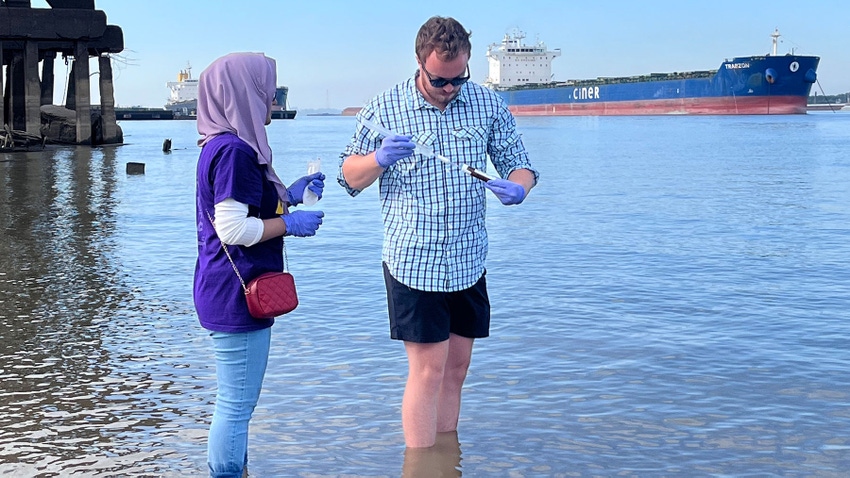March 14, 2023

By Mary Lang
LSU researchers are conducting a first-of-its-kind study exploring carbon transport in the Mississippi River that may lead to global applications.
For the past 10 years, LSU hydrologist Yi-Jun Xu has been studying dissolved carbon transport along the Mississippi River system to the Gulf of Mexico, as well as the emission of carbon into the atmosphere.
Dissolved carbon, both organic and inorganic, is carried in river systems. While the carbon cycle happens naturally in waterbodies, additional carbon can be added through decomposing materials like trees or, in this case, humans.
In the Mississippi River system, the carbon can either be carried into the Gulf of Mexico as an important food source for aquatic organisms or be returned to the atmosphere as carbon dioxide, the primary greenhouse gas emitted by humans.
Carbon introduction
Xu and graduate students Anamika Dristi and Lee Potter are now starting to determine how much carbon is introduced to natural water systems from wastewater treatment plants, an important source of cultural carbon.
Wastewater treatment plants collect household wastewater from residences, treat it through several processes, and release it back into the river.
"Wastewater treatment plants do not monitor and treat dissolved carbon. Right now, they try to remove silt and nitrogen, and they try to kill bacteria in water, but they do not have a process to remove carbon," Xu said. "If our study proves that the human contribution is very high, then that means it may be necessary to treat water also by reducing that released carbon content from the wastewater treatment plant."
It is believed that different environmental factors, such as diet and lifestyle, may influence the amount of carbon emitted from differing communities. Comparing samples between geographical areas along the river may help researchers estimate how much carbon is emitted into the river across the country and compare cultural carbon between communities.
Xu has received funding from the Provost's Fund for Innovative Research to expand his study.
Sample collection
His team is collecting samples from two wastewater treatment plants in Baton Rouge. They analyze the amount of dissolved organic and inorganic carbon in treated water directly from the plant and when it is released back into the river. With the funding, Xu plans to expand the study in New Orleans and other areas in the Mississippi River Basin.
"This kind of assessment has never been done before. We want to get an idea of how much carbon per person or per capital contributes every year to the river," Xu said. "If we have such information, we can estimate human direct contribution of carbon to the river from the entire Mississippi River Basin."
There has been very little research surrounding the area of cultural carbon transport via waterways. Xu hypothesizes that the human contribution of carbon to rivers is considerably high. If proven true, it would have relevant implications for policymakers and regulatory agencies like the EPA.
Approximately 70 million people live within the Mississippi River Basin, which includes connecting rivers like the Missouri River, Ohio River, Tennessee River, Arkansas River, Red River and many others that flow into it. Scaling up the project will allow Xu to gain a more precise estimate as to how much carbon per capita comes annually directly from human waste.
First-time date
Xu said that this study will not only provide first-time data, but its approach is transferrable to other rivers across the world. This study may help scientists make inferences about how much carbon per person is contributed by riverine systems across the globe.
"Scientists may want to get an idea of how much carbon per human is contributed to the Rhine River in Germany, for example, or the Mekong River in Vietnam," he said.
The good news is carbon dissolve is a fundamental food source to the biological systems in coastal water. Wetland organisms, like plants, fish, crawfish and crabs incorporate carbon.
Carbon is one of the most essential elements for water systems. As part of the carbon cycle, living organisms in the water consume carbon for either respiration or photosynthesis.
"Carbon in water is a very important food source, and at the same time, carbon is also an important element," Xu said. "And are the most important of greenhouse gases."
Carbon origination
However, scientists do not know how much carbon in the water originates directly from humans. It used to be thought that carbon in river water mainly originated from soil and residues, like decaying plants and dead animals.
"Carbon's an important element for the biological system, but we don't know how much carbon is in the river that actually does not come from the natural system, but from human impact," Xu said.
While the water itself is non-living, it is a medium with a delicate balance of organic and inorganic matter. Like soils, water systems host millions of living organisms, and certain qualities can make them ideal habitats for plants and aquatic animals.
"We are very excited about this research, and we wanted to move beyond this scope. By the end of this year, I'm hopeful we could generate some national competitive proposals," Xu said.
Source: Louisiana State University AgCenter
Read more about:
CarbonYou May Also Like




